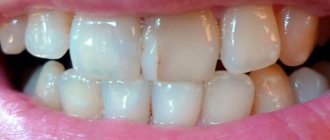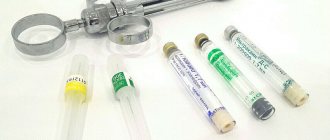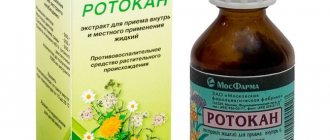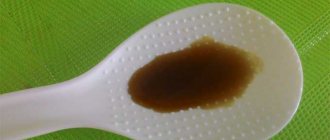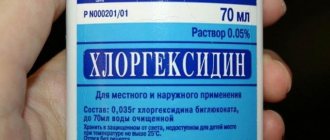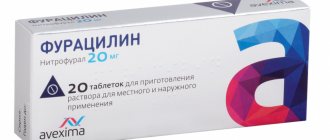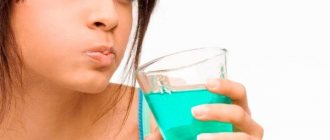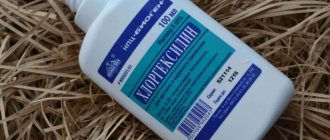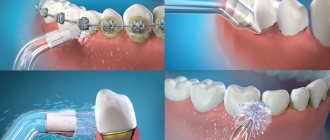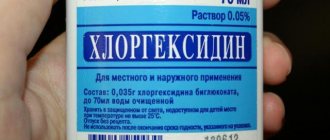From this article you will learn:
- Is it possible to rinse your mouth after removal,
- how to do it right,
- the better to rinse after tooth extraction.
The article was written by a dental surgeon with more than 19 years of experience.
Mouth rinsing after tooth extraction is the most common prescription prescribed by a dental surgeon after oral surgery. In most cases, solutions of antiseptics (medicines with antimicrobial activity) are used for mouth rinsing, or in some cases, saline solutions will be optimal. Most often, rinses are prescribed only after a complex tooth extraction, or if the extraction was carried out against the background of purulent inflammation.
Regular rinsing of the mouth with antiseptics can reduce the risk of developing alveolitis by approximately 80%, i.e. inflammation of the socket of an extracted tooth. However, if the patient rinses the mouth incorrectly, this, on the contrary, can lead to the blood clot falling out of the socket, the development of inflammation of the socket and the need for long-term treatment.
In addition to antiseptic solutions and soda-saline solutions, combined rinses can also be used, which, in addition to the antiseptic, additionally contain one or more anti-inflammatory components. Usually the latter are high concentrations of medicinal plants, which are found in a number of rinses. Such components additionally have a wound-healing effect, accelerating gum epithelization.
Features of wisdom teeth
Third molars are located deep in the mouth, at the very end of the lower and upper rows. Their differences from other teeth consist not only in such a delayed and slow eruption, but also in the development of complications accompanying this process.
Wisdom teeth are similar in structure to regular chewing teeth: they have a wide crown with cusps, several roots (2 on the lower jaw and 3 on the upper jaw). They usually do not have enough space at the end of the row, and in the immediate vicinity there are ligaments and chewing muscles attached that prevent these teeth from growing. Therefore, the “eights” tilt to the side, rest against the cheek, against the “neighbors,” or cannot cut through at all. Hence the unbearable pain.
The hygiene of third painters is difficult, so their enamel is quickly destroyed. In addition, if they rest against nearby teeth, they destroy them too.
Let's list the troubles that can be expected from wisdom teeth:
- caries - damage to the enamel, its blackening and the appearance of a hole;
- pericoronitis - inflammation of the tissues surrounding the tooth, and the formation of a mucous membrane over it - the so-called “hood”, under which food debris gets trapped, forming plaque. This provokes an unpleasant odor and inflammation with high temperature in this area;
- movement of other teeth in the row leading to pain (for example, canines);
- chronic cheek biting;
- compression of the branches of the ternary nerve, leading to numbness of part of the jaw and unpleasant sensations;
- the development of a cyst provoked by the presence of chronic inflammation around the tooth.
Based on the problems described above, it is quite clear that wisdom teeth have to be treated or removed, although this is difficult to do due to their location and also because their roots are either fused or intertwined.
Use of chlorhexidine in dentistry
You cannot do without it in dentistry, because it is merciless to the numerous and unnecessary microorganisms that live in our oral cavity. But its most important advantage is that this solution does not lose its disinfecting ability even in the presence of pus and blood. Dentists most often use chlorhexidine when required:
- disinfecting the doctor’s hands (before putting on medical gloves);
- treatment of complex inflammatory processes (for example, chronic generalized periodontitis);
- creating the maximum possible sterile conditions in the mouth necessary for tooth extraction without negative consequences;
- treatment of various diseases of the gums and mucous membranes at home;
- “superficial” anesthesia for dental treatment (used in conjunction with other necessary medications);
- treatment of the root canals of teeth.
Chlorhexidine is also included in many toothpastes and is used to rinse the mouth for various diseases.
Indications for removal and its nuances
Particularly lucky people are lucky: their “eights” cut through well and evenly. Experts recommend saving such teeth, but usually their nerves are removed, treated, and crowns are placed on them, preventing damage to the enamel. In other cases (see above), removal is the only way to get rid of dental diseases and pain.
Removal, as already mentioned, is complicated by the location of the molar deep in the mouth, in the thickness of the bone, the presence of inflammation, pus, and pain in the patient when opening the mouth. The doctor uses strong anesthesia and special instruments: forceps and elevators that remove individual roots.
After the operation, the pain in the jaw remains for some time and the wound bleeds a little. Swelling of the cheek is observed, usually after removal of a molar on the lower jaw - this is due to its structure and the body’s reaction to such an intervention. It may get stronger. There is also pain in the gums and cheeks when opening the mouth, eating and swallowing, and there may even be an increase in body temperature by several degrees. How long this will last depends on the patient’s health, the complexity of each individual case, the patient’s compliance with the doctor’s recommendations, etc. So, for some people everything goes away within three days, and for others whose gums were inflamed, there was pus or the dentist had to make an incision, healing will occur in five to seven days.
In any case, you need to follow the doctor’s recommendations so that healing takes place in a short time and with good quality. To make wisdom tooth removal comfortable, painless and quick, call and come to the Narodnaya dental clinic, where each patient is treated with care and attention.
Side effects
Any drug has limitations in use and may have side effects. Chlorhexidine is a safe antiseptic; however, an allergic reaction to it is possible. In addition, it can stain the enamel yellowish, cause a burning sensation and temporary loss of taste. During use of the product, a slight feeling of numbness and a feeling of bitterness may occur. The listed side effects are minor and are fully compensated by the high efficiency and availability of chlorhexidine.
Postoperative period
After removing a tooth, the dentist leaves a gauze swab in the mouth, which the patient must remove himself after 20 minutes for the wound to heal. You cannot eat or drink for 2 hours, then chew food on the other side until the hole heals.
Rinsing your mouth on the first day is strictly prohibited, since you can wash out the blood clot that protects it from the wound. It is formed from blood collected in the hole. For the same purpose, you should not brush nearby teeth with a brush.
Further brushing of these and other teeth is strongly recommended: particles of microbial plaque can enter the wound and cause inflammation.
It is necessary to take anti-inflammatory and antibacterial medications if prescribed by your dentist.
For healing and to prevent inflammation of the socket, it is necessary to regularly make oral baths with solutions, which we will discuss below.
Contraindications
Important! Chronic use of the drug may cause the appearance of a yellow-brown tint to tooth enamel. To avoid this, during the period of use of chlorhexidine, it is necessary to refrain from eating food containing intensely coloring pigments (red wine, bright soda, beets, coffee, tea, etc.).
In order to clean the plaque that has already formed, you will have to carry out a professional hygiene procedure. There are other features of the use of this antiseptic. Solutions based on it are not used for longer than two weeks to avoid the development of dysbacteriosis of the oral mucosa. At the same time, you cannot use iodine-containing products. Wait a while before rinsing with chlorhexidine after brushing your teeth with toothpaste. After consultation with your doctor, and provided there are no open wounds in the mouth, the drug can be used by pregnant and lactating women. Chlorhexidine is not contraindicated in childhood, however, it should be used under adult supervision to avoid ingestion of the solution.
Tea, wine, coffee, as well as cigarettes, chocolate, colored vegetables and fruits, sweets should be avoided during the period of preventive actions using chlorgrexidine, because combinations of such products and medications can cause darkening of tooth enamel.
How to rinse
Rinsing, or rather, passive oral baths , can be started one day after wisdom tooth removal. The technology is as follows: 4-5 times a day, preferably after meals, the solution is taken into the mouth, held there for a minute with the head tilted to the “sick” side, and spit out.
These can be the following purchased drugs , which contain an antibiotic:
- Dimexyl is very effective, but you should be careful with it, you should never swallow it;
- olasol;
- stomatidine;
- hexatidine;
- hexoral;
- olasol;
- givalex.
Chlorhexidine has a disinfecting effect. Its 0.05 percent solution relieves inflammation, pain, and swelling. You can also use the antimicrobial miramistin and tantum verde.
Furacilin is used to destroy pathogenic microflora. The solution is prepared as follows: place 10 tablets, 1 tsp in a liter of water. salt, bring the liquid to a boil and cool.
As for proven, effective and affordable folk options , these are:
- sea salt solution - disinfects the wound and prevents infection from developing. One teaspoon of salt is diluted in a glass of warm water;
- solution of potassium permanganate (potassium permanganate) – promotes healing, fights harmful microorganisms. It is prepared “by eye” - grains are added to the water in very small doses, literally one at a time, since the solution should be pale pink. A rich color indicates a danger of burns to the oral mucosa;
- soda solution - mechanically cleanses the oral cavity by creating gas bubbles and a strong alkaline environment. Dissolve a teaspoon of soda in a glass of warm water, stir and immediately take the liquid into your mouth;
- herbal infusion. You can take chamomile, sage, St. John's wort or thyme. Place a tablespoon of dry herb in a glass of hot water and leave for an hour. Next, the finished product is filtered;
- infusion of crushed chicory root or oak bark. They are prepared in the same way as herbal infusions.
It should be kept in mind: any rinse liquid should not be hot, but exceptionally warm.
Use of the drug in children and pregnant women
Attention! If there are no wounds in the patient's mouth, chlorhexidine can be used by pregnant and lactating women. It does not penetrate into the blood or breast milk, but acts only on the surface. A 10-day course of treatment is safe for such patients, according to studies.
When treating children, the course of use of the drug should also not exceed 10 days. For the youngest patients, it is preferable to use chlorhexidine in the form of a spray, which does not require rinsing skills. The spray is easy to use and can be applied to any area of the oral mucosa. Children under 3 years of age should not use the drug to irrigate the tonsils. Despite the safety of the drug, if the drug is used by pregnant women or pediatric patients, it is recommended to first consult with your doctor.
Do's and Don'ts
Let's return once again to what is recommended after wisdom tooth removal :
- strictly follow the recommendations of your doctor;
- make gentle oral baths;
- apply ice (cold) to the swollen cheek for 20–120 minutes;
- to relieve severe pain on the first day, take painkillers - Tempalgin, Pentalgin, Ketanov;
- if the temperature rises, a single dose of Aspirin, Ibuprofen, Paracetamol is allowed to bring it down;
- If prescribed by the doctor, take antibiotics in the dosage and duration prescribed by him. This cannot be neglected - there is a risk of abscess, periostitis, alveolitis, phlegmon.
Forbidden:
- rinse your mouth;
- treat the wound with iodine or brilliant green, ethyl alcohol and products containing it, hydrogen peroxide;
- warming the cheek will increase swelling, bleeding, and spread of infection;
- when applying sutures to the gums, open your mouth wide;
- eat spicy and very hard foods, small grains;
- pick the hole with a toothpick, explore it with a brush or tongue;
- visit a sauna or steam bath;
- engage in active sports, on exercise equipment.
If after a week or a little more the pain does not go away, the bleeding does not stop, the temperature does not go down, the swelling does not go away, or an unpleasant odor appears from the mouth, then you should definitely consult a dentist.
Description of the drug
Chlorhexidine is an antiseptic drug that has a disinfecting effect. Widely used to treat abrasions, damage and inflammation of the skin and mucous membranes.
The active component of the drug is chlorhexidine bigluconate .
Safe for use by young children, pregnant women and during lactation.
Dispensed without a doctor's prescription.
Similar antiseptics
In the pharmacy you can find many different antiseptics with properties similar to chlorhexidine. The most popular analogues are:
- Miramistin,
- Hydrogen peroxide,
- Furacilin.
It is worth considering each of them in a little more detail:
Miramistin
One of the best and most popular chlorhexidine analogues. Effectively fights pathogenic bacteria in the oral cavity, and also destroys herpes viruses. Quickly relieves inflammation in herpetic and viral stomatitis.
Another advantage of the drug is that it has absolutely no taste, does not change the color of teeth, does not cause skin allergies, and has a wider range of applications.
As for the disadvantages of miramistin, it costs several times more than chlorhexidine and is contraindicated in children under three years of age. Can be used with caution by women during pregnancy and lactation.
Hydrogen peroxide
Hydrogen peroxide is also often used to treat inflammatory diseases of the gums and mouth. Relieves pain and helps remove swelling. Effective as a means to flush out pus. Just like Chlorhexidine it is inexpensive.
You can use peroxide as a mouth rinse, but only under the supervision of your doctor.
Furacilin
It is widely used for the treatment of ENT diseases and inflammations of the oral cavity - stomatitis, gingivitis, sore throat, etc. The drug belongs to approximately the same price category as chlorhexidine.
The most commonly used solution is an aqueous solution made from tablets. To do this, 2 tablets of furatsilin are dissolved in 200 milliliters of warm water, after which the solution is ready for use.
